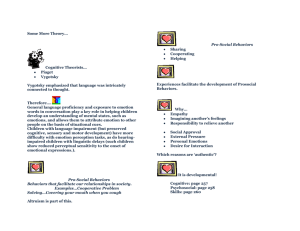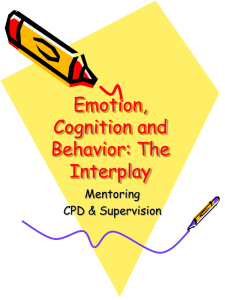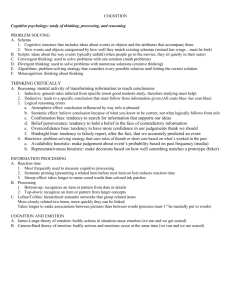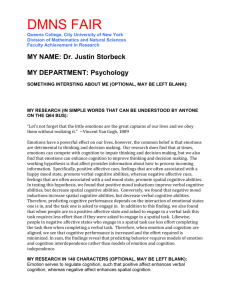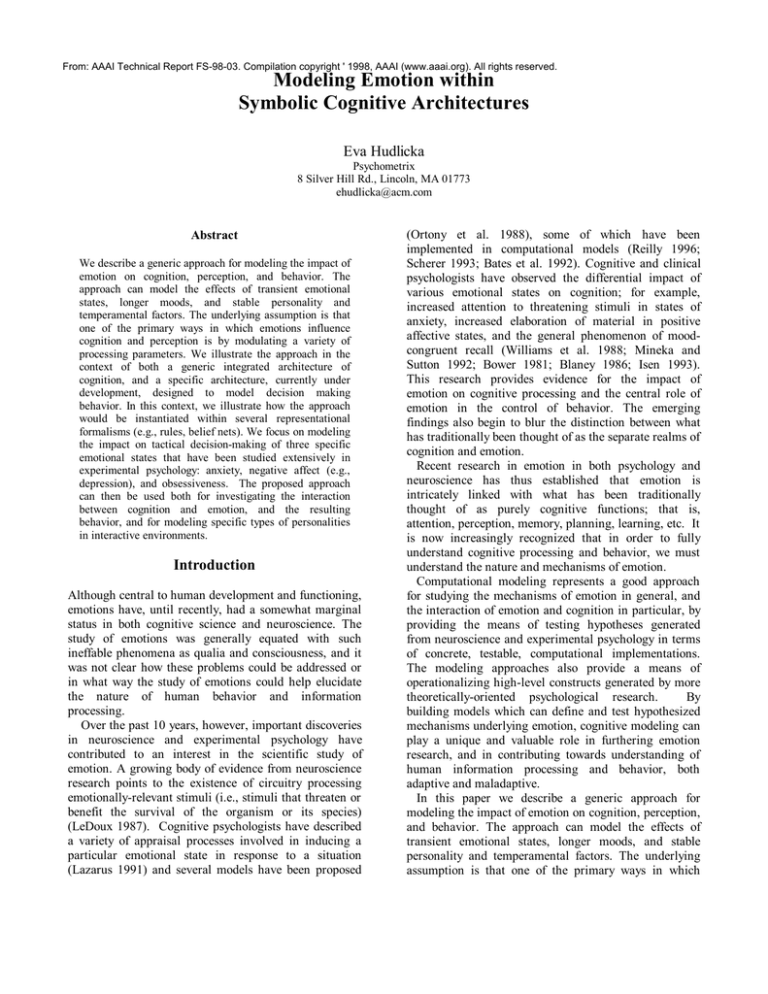
From: AAAI Technical Report FS-98-03. Compilation copyright ' 1998, AAAI (www.aaai.org). All rights reserved.
Modeling Emotion within
Symbolic Cognitive Architectures
Eva Hudlicka
Psychometrix
8 Silver Hill Rd., Lincoln, MA 01773
ehudlicka@acm.com
Abstract
We describe a generic approach for modeling the impact of
emotion on cognition, perception, and behavior. The
approach can model the effects of transient emotional
states, longer moods, and stable personality and
temperamental factors. The underlying assumption is that
one of the primary ways in which emotions influence
cognition and perception is by modulating a variety of
processing parameters. We illustrate the approach in the
context of both a generic integrated architecture of
cognition, and a specific architecture, currently under
development, designed to model decision making
behavior. In this context, we illustrate how the approach
would be instantiated within several representational
formalisms (e.g., rules, belief nets). We focus on modeling
the impact on tactical decision-making of three specific
emotional states that have been studied extensively in
experimental psychology: anxiety, negative affect (e.g.,
depression), and obsessiveness. The proposed approach
can then be used both for investigating the interaction
between cognition and emotion, and the resulting
behavior, and for modeling specific types of personalities
in interactive environments.
Introduction
Although central to human development and functioning,
emotions have, until recently, had a somewhat marginal
status in both cognitive science and neuroscience. The
study of emotions was generally equated with such
ineffable phenomena as qualia and consciousness, and it
was not clear how these problems could be addressed or
in what way the study of emotions could help elucidate
the nature of human behavior and information
processing.
Over the past 10 years, however, important discoveries
in neuroscience and experimental psychology have
contributed to an interest in the scientific study of
emotion. A growing body of evidence from neuroscience
research points to the existence of circuitry processing
emotionally-relevant stimuli (i.e., stimuli that threaten or
benefit the survival of the organism or its species)
(LeDoux 1987). Cognitive psychologists have described
a variety of appraisal processes involved in inducing a
particular emotional state in response to a situation
(Lazarus 1991) and several models have been proposed
(Ortony et al. 1988), some of which have been
implemented in computational models (Reilly 1996;
Scherer 1993; Bates et al. 1992). Cognitive and clinical
psychologists have observed the differential impact of
various emotional states on cognition; for example,
increased attention to threatening stimuli in states of
anxiety, increased elaboration of material in positive
affective states, and the general phenomenon of moodcongruent recall (Williams et al. 1988; Mineka and
Sutton 1992; Bower 1981; Blaney 1986; Isen 1993).
This research provides evidence for the impact of
emotion on cognitive processing and the central role of
emotion in the control of behavior. The emerging
findings also begin to blur the distinction between what
has traditionally been thought of as the separate realms of
cognition and emotion.
Recent research in emotion in both psychology and
neuroscience has thus established that emotion is
intricately linked with what has been traditionally
thought of as purely cognitive functions; that is,
attention, perception, memory, planning, learning, etc. It
is now increasingly recognized that in order to fully
understand cognitive processing and behavior, we must
understand the nature and mechanisms of emotion.
Computational modeling represents a good approach
for studying the mechanisms of emotion in general, and
the interaction of emotion and cognition in particular, by
providing the means of testing hypotheses generated
from neuroscience and experimental psychology in terms
of concrete, testable, computational implementations.
The modeling approaches also provide a means of
operationalizing high-level constructs generated by more
theoretically-oriented psychological research.
By
building models which can define and test hypothesized
mechanisms underlying emotion, cognitive modeling can
play a unique and valuable role in furthering emotion
research, and in contributing towards understanding of
human information processing and behavior, both
adaptive and maladaptive.
In this paper we describe a generic approach for
modeling the impact of emotion on cognition, perception,
and behavior. The approach can model the effects of
transient emotional states, longer moods, and stable
personality and temperamental factors. The underlying
assumption is that one of the primary ways in which
emotions influence cognition and perception is by
modulating a variety of processing parameters. We
illustrate the approach in the context of both a generic
integrated architecture of cognition, and a specific
architecture, currently under development, designed to
model decision making behavior. In this context, we
illustrate how the approach would be instantiated within
several representational formalisms (e.g., rules, belief
nets). We focus on modeling the impact on tactical
decison-making of three specific emotional states that
have been studied extensively in experimental
psychology: anxiety, negative affect (e.g., depression),
and obsessiveness. The proposed approach can then be
used both for investigating the interaction between
cognition and emotion, and the resulting behavior, and
for modeling specific types of personalities in interactive
environments.
Impact of Emotional States on Cognitive
Processing and Behavior
In this section we first provide a brief review of recent
research in the impact of emotion on cognitive
processing and behavior, and outline a set of parameters
which could serve as candidates for modeling emotional
states. We then provide examples showing the impact of
these states on specific real-time planning and tactical
decision-making.
Empirical Evidence
A number of studies in cognitive and experimental
psychology have documented the differential impact of
various emotional states on cognition. Three affective
states and traits have been studied extensively: anxiety,
obsessiveness, and depression, and the findings of these
studies are briefly summarized below and in table 1.
Anxiety The primary impact of anxiety is on attention.
Specifically, anxiety narrows the focus of attention,
predisposes towards the detection of threatening stimuli,
and predisposes towards the interpretation of ambiguous
stimuli as dangerous (Williams et al. 1997; Mineka and
Sutton 1992).
Obsessiveness A number of studies have documented
the impact of high-obsessiveness, characterized by
"checking" behavior, on cognitive processing. Among the
primary effects identified are the following: lack of
confidence in own attention apparatus to capture salient
features in the environment (Broadbent et al. 1986);
narrow conceptual categories (Reed 1969; Persons and
Foa 1984); poor memory for previous actions and a
general lack of certainty about own ability to distinguish
between events that occurred vs. those that were planned
or imagined (Sher et al. 1989), and slower decisionmaking speed related to obsessive gathering of
confirming information (Sher et al. 1989).
Depression The primary impact of depression is on
memory, with the best documented phenomenon being
mood-congruent recall (Bower 1981; Blaney 1986); that
is, the observation that a particular affective mood
induces recall of similarly valenced memories (e.g.,
depressed mood enhances recall of negative experiences
and events in the past, including negative selfappraisals). Depression has also been studied in the
context of particular inferencing tasks, such as judgment
and decision-making. In these tasks depression appears
to lower estimates of the degree of control (Isen 1993).
The research summarized above provides evidence for
the ubiquitous impact of emotion on cognitive
processing, and the central role of emotion in the control
of behavior. The emerging findings also begin to blur the
distinction between what has traditionally been thought
of as the separate realms of cognition and emotion.
Impact of Emotions on Tactical Decision-Making
Anxiety and Attention
Narrowing of attentional focus
Predisposing towards detection of threats
Mood and Memory
Mood-congruent recall-an affective state induces
recall of similarly valenced material
Obsessiveness and Performance
Delayed decision-making
Reduced ability to recall recent activities
Narrow conceptual categories
Affect and Judgment & Perception
Depression lowers estimates of degree of control
Anxiety predisposes towards interpretation of
ambiguous stimuli as threatening
Table 1: Impact of Emotion on Cognition
To illustrate the approach in a concrete context, we now
briefly outline the impact of selected affective states on
tactical decision-making; specifically, we focus on the
different phases and aspects of decision-making of a
Army platoon leader during mission planning. The
scenario for this mission is described elsewhere (Pew &
Mavor 1998). Table 2 summarizes examples of specific
impacts of the selected emotional states on the platoon
leader’s decision making.
Overall Situation Analysis
• Depressed state induced by general combat stress level
can induce recall of previous failures and bias
against the considerations of otherwise suitable course of
action alternatives
Situation Estimate and Course of Action Development
• Depressed leader may overestimate likelihood of losing
critical equipment (e.g., helicopters), and may either not
employ appropriate units, or may construct an overlycautious plan
• Obsessive leader may micro manage his staff, thus
creating bottlenecks during the planning process.
• Anxious leader may overestimate danger potential and
choose an overly conservative course of action
• Obsessive leader may rehearse more thoroughly,
thereby increasing chances of mission success
Plan Monitoring and Execution
• Anxious leader may interpret a ambiguous signals as
the approaching enemy and fire too early, thus betraying
platoon's position or risking fratricide
• Low-anxiety leader may fail to react to warnings due to
high risk tolerance, putting personnel at greater risk
• Obsessive leader may not trust incoming data about
approaching enemy and wait too long before initiating
action
Table 2: Examples of Specific Emotions and their Impact
on the Mission Planning Process
Generic Methodology for Modeling Emotions
in Symbolic Cognitive Architectures
Early analytical, parametric, output-oriented models of
cognition and performance allowed only stochastic
perturbations of output behavior variables, such as speed
or accuracy. These models generally did not provide
adequate scope or parameter resolution within which to
represent the individual differences behavior moderators
discussed above. In other words, the human behavior
representation within these models did not provide
sufficient breadth to allow for an effective representation
of individual variations in intelligence, skill level, and
personality.
In contrast to the early modeling methods, recent
modeling approaches allow more finely-tuned alterations
of information processing via a number of parameters
influencing specific cognitive modules or processes; e.g.,
perception, attention, memory, inferencing, and learning.
This is particularly the case for integrated symbolic
architectures such as Soar (Newell 1990) and ACT
(Anderson 1983), but also for earlier parameterized
models such as Model Human Processor (MHP) (Card et
al. 1986). A number of more recent modeling efforts also
fall within this category (Hudlicka 1994; Hudlicka et al.
1992; Zacharias et al. 1996). These models typically
consist of a number of modules and processes that either
already are parameterized, or lend themselves to be
parameter-controlled (e.g., in MHP, parameters control
both the capacity and speed of access and decay of
various memory stores; in ACT, parameters control the
individual node thresholds in semantic memory and the
speed of spreading activation).
In addition to parameter-controlled processing,
symbolic cognitive architecture models also lend
themselves to modeling emotional states, moods, and
temperamental and personality factors in terms of the
model structures (e.g., memory organization and
content), represented in the knowledge-bases of the
architecture components. For example, the type and
number of rules in Soar, and the type and number of
semantic network nodes in ACT, can be tailored to
encode specific types of domain knowledge and
individual history, with associated affective valence, and
thereby generate different types of model behavior.
Table 3 lists examples of modeling parameters and
model features that can be used to represent emotioninduced variations in these types of cognitive
architectures. The space of possible behaviors defined by
these parameters can accommodate the wide variability
of behaviors due to specific emotional states, and the
interaction of these states with a particular situation. As
such, these modeling parameters provide an effective
means of representing the impact of a variety of emotions
and emotional states on behavior, including transient
states, longer lasting moods, and more or less permanent
temperamental and personality factors. This capability
can then be used both for investigating the interaction
between cognition and emotion, and the resulting
behavior, and for modeling specific types of personalities
in interactive environments.
To summarize, the behaviors described in table 2, and
additional emotion-induced behaviors, can be modeled
within a cognitive architecture in two primary ways:
• By manipulating the architecture structures, to
reflect the desired characteristics; e.g., by
constructing the memory modules in such a way that
the desired behaviors can be generated.
• By manipulating the architecture processing
parameters, to reflect a particular emotional
orientation or emotional state, thereby biasing the
architecture behavior in a particular direction.
This general approach is illustrated in figure 1.
Attention
Scan speed; Ease of engagement / disengagement
Scan intensity; Selectivity
Memory
Content
Degree of conceptual complexity and differentiation
Type and size of memory units
Retrieval
Speed and accuracy of retrieval
Divergent vs. convergent search
Organization
Type of internal structure (e.g., hierarchy, causal model)
Level of interconnectivity among knowledge units
Perception
Specificity of matching
Speed of detection and matching processes
Inferencing
Generic
Speed of inferencing; Decay of activated units
Specific
Meta-cognitive inferencing; What-if simulation
Causal analysis; Data-driven vs. goal-driven processing
Recall vs. derivation of required data
Table 3: Cognitive Architecture Parameters and Features
Capable of Modeling Impact of Emotions on Cognition
Individual Differences
Parameters
Personality
Anxiety tolerance
Negative emotionality
Obsessiveness
Individual History
Previous incidents
Preferred maneuvers
Cognitive Style
Bias susceptibility
Attentional factors
Case-based vs. 1st
principles reasoning
Skill & Training Level
Preferred maneuvers
Specific areas of strength
Cognitive Architecture
Parameters
Cognitive Architecture
.
unexpected heavy continue engagement vs
fighting and losses
retreat
Perception
Specificity
Bias towards threats
Inferencing
Recall vs. derivation
Attention
Selectivity
Speed
Distractibility
Memory
Retrieval speed
Retrieval accuracy
Content
Perception
Inferencing
Attention
Working Mem.
Long Term Mem.
MODEL OUTPUT:
Commander with low anxiety tolerance, high negative emotionality, and preference
for case-based reasoning retrieves previous failed operations when under stress
and retreats, rather than exploring alternative options for continued engagement
Figure 1: Summary of Proposed Approach for
Representing Emotions within a Generic Cognitive
Architecture
Modeling Emotions within Specific
Representational Formalisms
We first illustrate the approach in the context of two well
known cognitive architectures: Soar and ACT. We then
illustrate the approach within a cognitive architecture for
modeling decision-making currently under development:
the SAMPLE architecture (Zacharias et al. 1996).
SAMPLE consists of several modules using a variety of
representational formalisms (e.g., Bayesian belief nets,
rules, scripts), which will allow us to demonstrate the
applicability of the proposed methodology across a
variety of representational and reasoning formalisms.
Modeling Emotions within Soar and ACT
Both Soar and ACT are well-suited for modeling the
impact of emotion, both in terms of structure and
processing. Modeling emotions in terms of structure
(i.e., domain knowledge) can be accomplished by varying
the type and number of operators (i.e., rules) or nodes
with a particular affective content (e.g., likely to trigger
anxiety, likely to interpret a signal as threatening, etc.).
Modeling emotions in processing can be accomplished by
varying the following components of these two
architectures:
• Capacity of working memory (i.e., maximum number of
rules in working memory).
• Degree and nature of rule or node interconnectedness
within Soar and ACT long-term memory, which impacts
mood-congruent recall.
• Accuracy, speed, and bias of rule matching process,
which influence processing at any point in the
computational cycle by influencing: 1) problem
space/rule selection; 2) state selection; and 3) operator
selection.
• Relative proportion of automatic and controlled
processing determined by defining the proportion
between elaboration and decision phases in rule selection.
• Speed of spreading activation through semantic
memory as determined by node thresholds and link
strength.
• Accuracy and speed of matching between nodes in
declarative memory and rules in procedural memory by
varying the parameters controlling: 1) degree of match;
2) production strength; 3) data refractory period; 4)
specificity; and 5) goal dominance.
• Degree of goal-directed processing by varying the
ability of goals to provide/maintain node activation.
Modeling Emotion within the SAMPLE
Architecture
We now illustrate the proposed approach in the context
of a cognitive architecture currently under development:
the SAMPLE architecture (Zacharias et al. 1996).
narrowing of attentional focus, and can either cause
greater degree of distractibility or can cause delay in
attentional shifts (Williams 1997; Mineka 1992; Eysenck
1997). Obsessive "checking behaviors" can be modeled
by requiring multiple scans of input data before sufficient
confidence is generated (Broadbent et al. 1986).
Analyst
Analyst Interaction GUI
Task/Scenario
Definition
Individual Profile
(Cognitive, Affective,
Personality Factors)
Model Behavior
Output
Model Knowledge Base & Processing Parameters
SAMPLE Cognitive Architecture
Task /
Scenario
Simulation
Module
Sensory Input
Visual
Monitor
State Estimator &
Event Detector
Auditory
sensory data
attended-to input
cues / states
Procedure
Executor
Decision
Maker
selected actions
Situation
Assessor
recognized situations
Data Recording & Result Analysis Module
Figure 2: SAMPLE Cognitive Architecture Modeling
Decision-Making Integerated within a Testbed Simulation
Environment
This architecture, illustrated in figure 2, is designed to
model tactical decision-making and consists of the
following modules: monitor, state estimator and event
detector, situation assessor, decision-maker, and
procedure executor. The architecture includes several
representational formalisms and as such represents a
good testbed for demonstrating how the proposed
approach can be instantiated within a number of specific
representational systems. We now describe two of these
modules in detail and illustrate how they model the
impact of specific emotional states.
Monitor The monitor module selects a specific sensory
input for processing and functions as an attention
process. This module is implemented as a collection of
procedures whose primary function is to make specific
information from environment available to the state
estimator and event detector module. Parameters
controlling the monitor behavior include the following:
• Structure parameters: Orientation towards particular
content (e.g., threatening stimuli);
•
Process parameters: Scan speed, time required for
engagement / disengagement, strength of stimulus
required for attentional shifts (distractibility),
selectivity, size of focal area.
These parameters represent primarily the impact of
anxiety, which includes focus on threatening stimuli,
Situation Assessor The situation assessor module
combines low-level variables and events (e.g., 3 vehicles
approaching from the N at 10 km/hour) into high-level
descriptions of specific situations (e.g., approaching
enemy unit of size X), and mapping them onto situation
types that suggest a particular response (e.g., withdraw
patrols). The situation assessor is implemented as a set of
belief nets (Pearl 1986), representing knowledge in terms
nodes and links. Nodes represent particular features and
events (e.g., vehicle moving from location x,y and
approaching), intermediate results (e.g., vehicle entering
friendly zone), and final overall situation types (e.g.,
initiation of engagement). Links represent causal and
correlational relations between events and situations
represented by the nodes, and are associated with weights
representing probabilities of each transition. Parameters
controlling the situation assessor include the following:
• Structure parameters: Content of BN nodes, number of
nodes, network topology, BN probability matrix.
• Process parameters: Speed of propagation of probability
weights along BN links, affective valence associated with
particular nodes (e.g., a value associated with a particular
situation or feature indicating whether it is desirable or
undesirable).
Personality and affective factors are represented in this
module by associating a specific affective value (positive
or negative) with existing situations represented by the
individual BN nodes. Negative or positive emotionality is
then modeled by matching the decision-maker's affective
state or predominant temperamental factors with
similarly valenced situations in the belief net memory,
thus causing certain situations to be recalled
preferentially, due to mood-congruent recall, increasing
the likelihood of their recognition, while failing to recall
others, decreasing the likelihood that they will be
selected during situation assessment. Obsessiveness can
be modeled by reducing the overall processing speed of
the situation assessment process, by reducing the
confidence in the derived situations, thereby requiring
additional data or additional passes over existing data to
reach the desired level of confidence.
Conclusions
We have described a methodology for modeling the
impact of emotion on cognition and perception, within
the general context of symbolic cognitive architectures.
We have illustrated this approach in the context of a
specific symbolic architecture, designed to model tactical
decision-making, in terms of a variety of representational
formalisms (e.g., rules, belief nets). We focused on
modeling the impact of three well-studied emotional
states: anxiety, negative affect, and obsessiveness.
The proposed methodology is suitable not only for
modeling the influence of emotional states, moods, and
stable personality factors on cognition and behavior, but
also for modeling a larger spectrum of individual
differences. These include cognitive and decision-making
styles, susceptibility to particular cognitive and
perceptual biases, training and skill level, and individual
history.
The resulting models can then be used both for
investigating the mechanisms of emotion and the
interaction between cognition and emotion, and for
modeling specific types of personalities and individual
styles in interactive simulation and training
environments.
We are currently developing the parameterized
SAMPLE architecture and its associated testbed
environment, designed to facilitate the investigation of
the above phenomena.
Acknowledgments
The author would like to acknowledge Dr. Greg
Zacharias of Charles River Analytics for extended
discussions about the SAMPLE cognitive architecture
and its potential for representing emotions and individual
differences.
References
Anderson, J. 1983. The architecture of cognition.
Cambridge, MA: Harvard University Press.
Bates, J., Loyall, A.B., and Reilly, W.S. 1992.
Integrating Reactivity, Goals, and Emotion in a Broad
Agent. In Proceedings of the 14th Meeting of the
Cognitive Science Society.
Blaney, P.H. 1986. Affect and Memory. Psychological
Bulletin, 99(2):229-246.
Bower, G.H. 1981. Mood and Memory. American
Psychologist, 36:129-148.
Broadbent, D.E., Broadbent, M.H.P, and Jones, J.L.
1986) Performance correlates of self-reported cognitive
failure and obsessionality. British Journal of Clinical
Psychology, 25:285-299.
Card, S.K., Moran, T.P., and Newell, A. 1986. The
Model Human Processor: An Engineering Model of
Human Performance. In Handbook of Perception and
Human Performance, Vol. II, K. Boff, L. Kaufman, & J.
Thomas, eds., New York, NY: John Wiley & Sons.
Eysenck, M.W. 1997. Anxiety and Cognition: A Unified
Theory. Hove, E. Sussex: Psychology Press.
Hudlicka, E. 1994. Toward a Computational Model of
Attention. BBN Report. No. 7791. Cambridge, MA: BBN
Hudlicka, E., Adams, M.J., and Feehrer, C.E. 1992.
Computational Cognitive Models: Phase I. BBN Report
No. 7752. Cambridge, MA: BBN
Isen, A.M. 1993. Positive Affect and Decision Making.
In Handbook of Emotions, J.M. Haviland and M. Lewis,
eds. New York, NY: The Guilford Press.
Lazarus, R.S. 1991. Emotion and Adaptation. New
York, NY: Oxford University Press.
Ledoux, J.E. 1987. Emotion. The Nervous System V.
Bethesda, Maryland, American Physiological Society.
419-460.
MacLeod, C. and Hagan, R. 1992. Individual differences
in the selective processing of threatening information.
Behav. Res. Ther., 30:151-161.
Mineka, S. and Sutton, S.K. 1992. Cognitive Biases and
the Emotional Disorders. Psychological Science, 3(1):6569.
Newell, A. 1990. Unified theories of cognition.
Cambridge, MA: Harvard University Press.
Ortony, A., Clore, G.L., and Collins, A. 1988. The
Cognitive Structure of Emotions.
NY: Cambridge
University Press.
Persons, J.B. and Foa, E.B. 1984. Processing of fearful
and neutral information by obsessive-compulsives.
Behavior Res. Ther., 22:260-265.
Pew, R.W. and Mavor, A.S. 1998. Representing Human
Behavior in Military Simulations. Washington, DC.
National Academy Press 1998.
Reed, G.F. 1969. Under-inclusion - a characteristic of
obsessional personality. British Journal of Psychiatry,
115:781-785.
Reilly, W.S.N. 1996. Believable Social and Emotional
Agents. Ph.D. Report No. CMU-CS-96-138. Pittsburgh,
PA: Carnegie Mellon University.
Scherer, K. 1993. Studying the Emotion-antecedent
appraisal process: The expert system Approach.
Cognition and Emotion, 7:325-355.
Sher, K.J., Frost, R.O., Kushner, M., Crews, T.M. and
Alexander, J.E. 1989. Memory deficits in compulsive
checkers: replication and extension in a clinical sample.
Behavior Res. Ther., 27:65-69.
Williams, J.M.G., Watts, F.N., MacLeod, C., and
Mathews, A. 1997. Cognitive Psychology and Emotional
Disorders. NY: John Wiley.
Zacharias, G.L., Miao, A.X, Illgen, C., and Yara, J.M.
1996. SAMPLE. In Proceedings of the 1st Annual
Conference on Situation Awareness in the Tactical Air
Environment. WPAFB, OH: CSEI Analysis Center.

